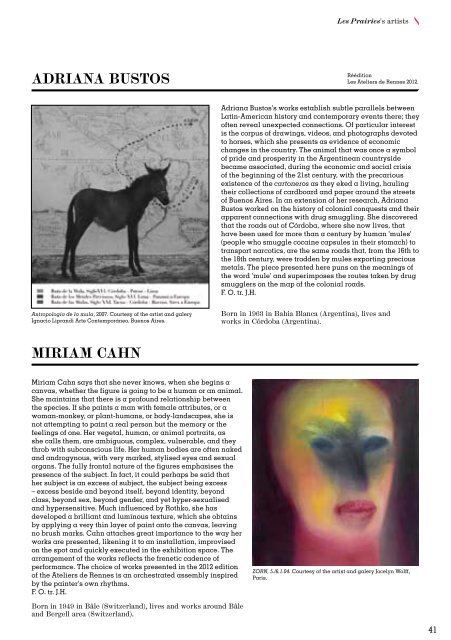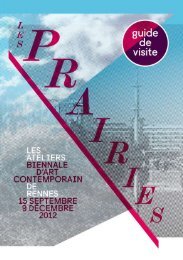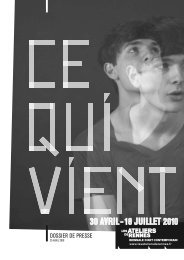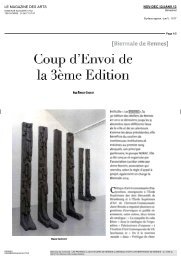Download here the Visitor's guide. - Les Ateliers de Rennes
Download here the Visitor's guide. - Les Ateliers de Rennes
Download here the Visitor's guide. - Les Ateliers de Rennes
You also want an ePaper? Increase the reach of your titles
YUMPU automatically turns print PDFs into web optimized ePapers that Google loves.
ADRIANA BUSTOS<br />
Antropología <strong>de</strong> la mula, 2007. Courtesy of <strong>the</strong> artist and galery<br />
Ignacio Liprandi Arte Contemporáneo, Buenos Aires.<br />
MIRIAM CAHN<br />
Miriam Cahn says that she never knows, when she begins a<br />
canvas, whe<strong>the</strong>r <strong>the</strong> figure is going to be a human or an animal.<br />
She maintains that t<strong>here</strong> is a profound relationship between<br />
<strong>the</strong> species. If she paints a man with female attributes, or a<br />
woman-monkey, or plant-humans, or body-landscapes, she is<br />
not attempting to paint a real person but <strong>the</strong> memory or <strong>the</strong><br />
feelings of one. Her vegetal, human, or animal portraits, as<br />
she calls <strong>the</strong>m, are ambiguous, complex, vulnerable, and <strong>the</strong>y<br />
throb with subconscious life. Her human bodies are often naked<br />
and androgynous, with very marked, stylised eyes and sexual<br />
organs. The fully frontal nature of <strong>the</strong> figures emphasises <strong>the</strong><br />
presence of <strong>the</strong> subject. In fact, it could perhaps be said that<br />
her subject is an excess of subject, <strong>the</strong> subject being excess<br />
– excess besi<strong>de</strong> and beyond itself, beyond i<strong>de</strong>ntity, beyond<br />
class, beyond sex, beyond gen<strong>de</strong>r, and yet hyper-sexualised<br />
and hypersensitive. Much influenced by Rothko, she has<br />
<strong>de</strong>veloped a brilliant and luminous texture, which she obtains<br />
by applying a very thin layer of paint onto <strong>the</strong> canvas, leaving<br />
no brush marks. Cahn attaches great importance to <strong>the</strong> way her<br />
works are presented, likening it to an installation, improvised<br />
on <strong>the</strong> spot and quickly executed in <strong>the</strong> exhibition space. The<br />
arrangement of <strong>the</strong> works reflects <strong>the</strong> frenetic ca<strong>de</strong>nce of<br />
performance. The choice of works presented in <strong>the</strong> 2012 edition<br />
of <strong>the</strong> <strong>Ateliers</strong> <strong>de</strong> <strong>Rennes</strong> is an orchestrated assembly inspired<br />
by <strong>the</strong> painter's own rhythms.<br />
F. O. tr. J.H.<br />
Born in 1949 in Bâle (Switzerland), lives and works around Bâle<br />
and Bergell area (Switzerland).<br />
<strong>Les</strong> Prairies's artists<br />
Réédition<br />
<strong>Les</strong> <strong>Ateliers</strong> <strong>de</strong> <strong>Rennes</strong> 2012.<br />
Adriana Bustos's works establish subtle parallels between<br />
Latin-American history and contemporary events t<strong>here</strong>; <strong>the</strong>y<br />
often reveal unexpected connections. Of particular interest<br />
is <strong>the</strong> corpus of drawings, vi<strong>de</strong>os, and photographs <strong>de</strong>voted<br />
to horses, which she presents as evi<strong>de</strong>nce of economic<br />
changes in <strong>the</strong> country. The animal that was once a symbol<br />
of pri<strong>de</strong> and prosperity in <strong>the</strong> Argentinean countrysi<strong>de</strong><br />
became associated, during <strong>the</strong> economic and social crisis<br />
of <strong>the</strong> beginning of <strong>the</strong> 21st century, with <strong>the</strong> precarious<br />
existence of <strong>the</strong> cartoneros as <strong>the</strong>y eked a living, hauling<br />
<strong>the</strong>ir collections of cardboard and paper around <strong>the</strong> streets<br />
of Buenos Aires. In an extension of her research, Adriana<br />
Bustos worked on <strong>the</strong> history of colonial conquests and <strong>the</strong>ir<br />
apparent connections with drug smuggling. She discovered<br />
that <strong>the</strong> roads out of Córdoba, w<strong>here</strong> she now lives, that<br />
have been used for more than a century by human 'mules'<br />
(people who smuggle cocaine capsules in <strong>the</strong>ir stomach) to<br />
transport narcotics, are <strong>the</strong> same roads that, from <strong>the</strong> 16th to<br />
<strong>the</strong> 18th century, were trod<strong>de</strong>n by mules exporting precious<br />
metals. The piece presented <strong>here</strong> puns on <strong>the</strong> meanings of<br />
<strong>the</strong> word 'mule' and superimposes <strong>the</strong> routes taken by drug<br />
smugglers on <strong>the</strong> map of <strong>the</strong> colonial roads.<br />
F. O. tr. J.H.<br />
Born in 1963 in Bahia Blanca (Argentina), lives and<br />
works in Córdoba (Argentina).<br />
ZORN, 5./6.1.04. Courtesy of <strong>the</strong> artist and galery Jocelyn Wolff,<br />
Paris.<br />
41






